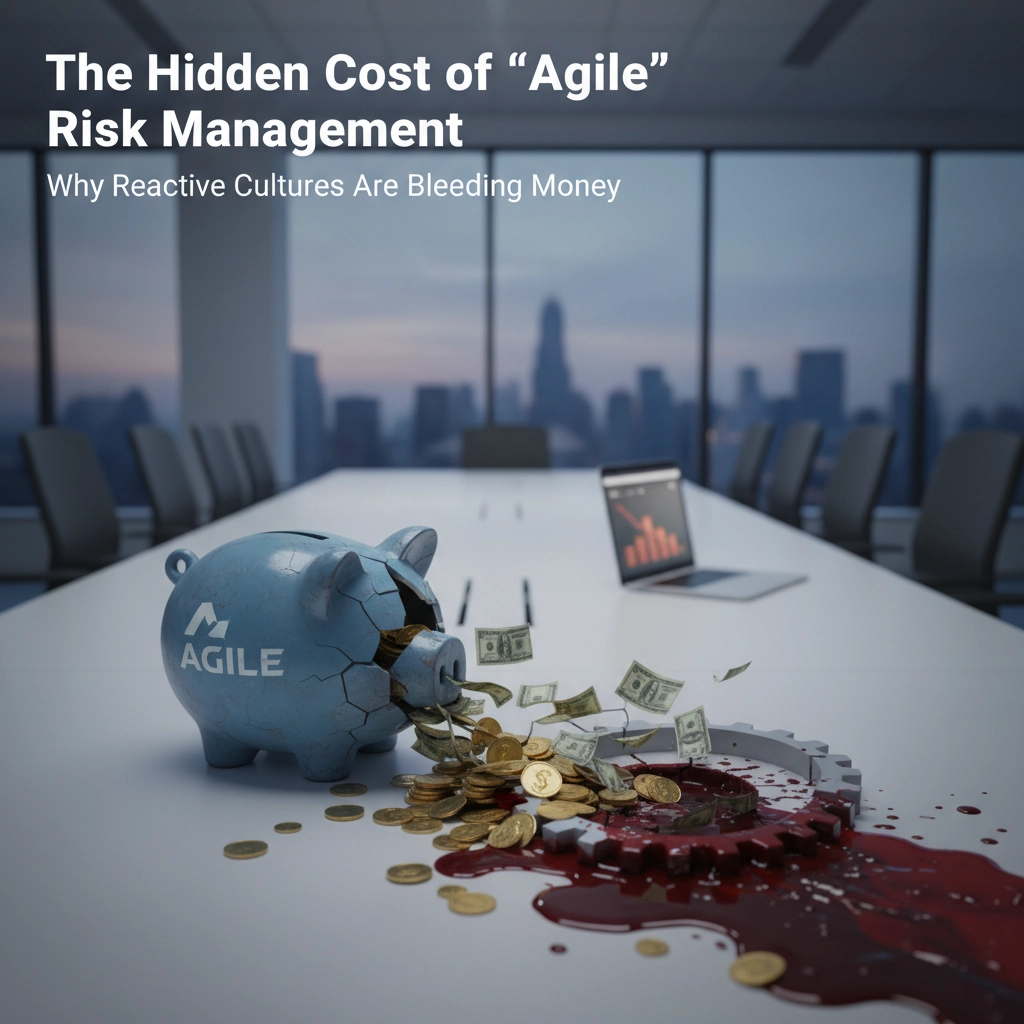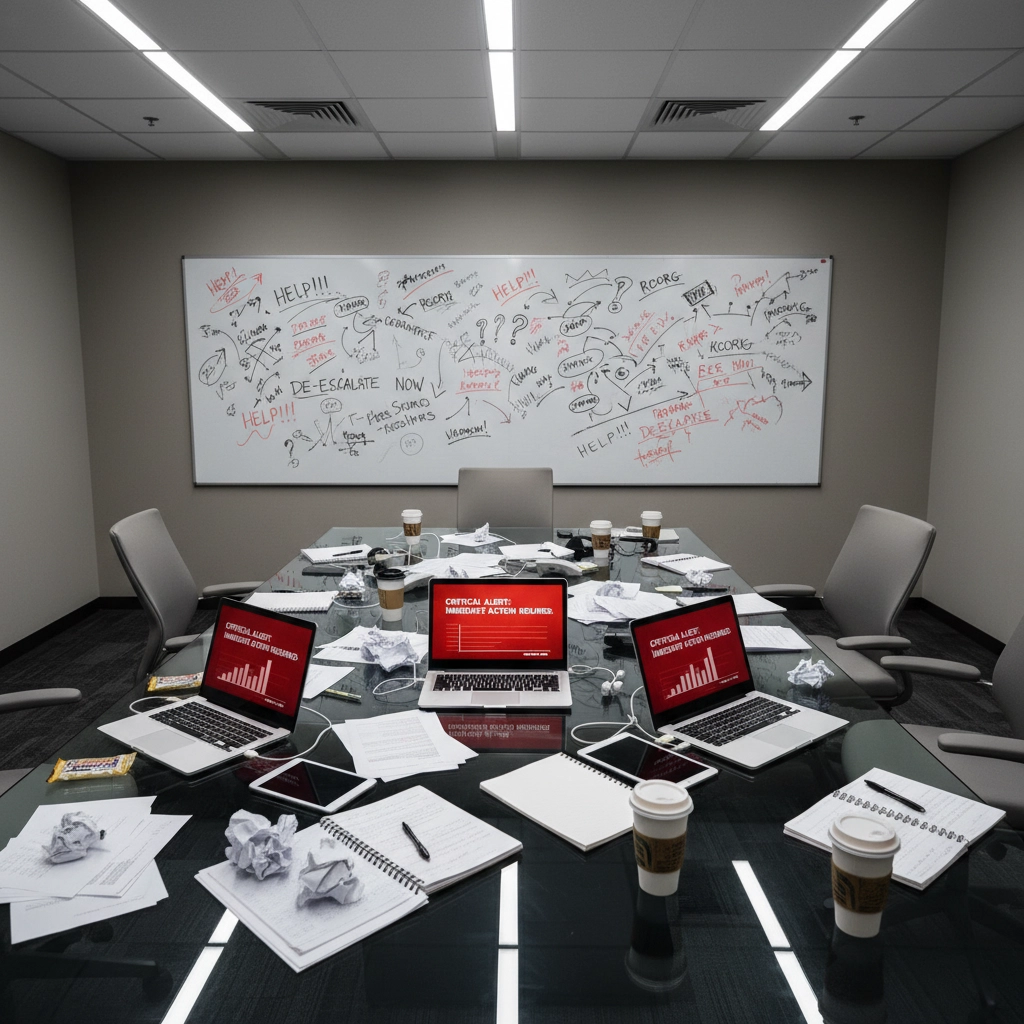
Think your “agile” risk management is keeping you competitive? Think again.
You’re probably bleeding money right now. And the worst part? You don’t even see it happening.
Here’s the brutal truth: Most CEOs have confused agile principles with reactive panic. They’ve built cultures that chase symptoms instead of solving root causes. The result? A financial hemorrhage disguised as operational efficiency.
The Agile Mask: When Speed Becomes Your Slowest Asset
You’ve heard the pitch a thousand times. “Move fast, break things, iterate quickly.” Sounds revolutionary, right?
Wrong.
85% of companies implementing “agile” risk management are actually creating reactive cultures that cost them 3x more than traditional approaches.
Here’s what’s really happening behind the performance mask:
Your team isn’t agile. They’re in constant crisis mode.
→ Every “urgent” meeting becomes a firefighting session
→ Every decision gets made under artificial pressure
→ Every solution addresses the symptom, not the disease

Real-World Snapshot: “Code Red” Isn’t a Strategy
When Sam Altman reportedly hit “code red” inside OpenAI to counter Google Gemini and Anthropic’s surge, it looked like decisive leadership. Think again.
Even world-class companies can confuse motion with momentum. The mask fits everywhere.
- Headlines spike → burn rate spikes faster
- More launches → more rework, more distraction
- Activity reads as progress → pipeline slips, morale dips
If OpenAI can get pulled into scramble mode, your org can too. Constant emergency ≠ agility. It’s adrenaline. And adrenaline is expensive.
Translate that into your P&L and talent risk:
- Cost: Compounded rework, duplication, vendor churn, ballooning contractor spend
- Time: Decision whiplash, priority churn, slow-noise that kills velocity
- Talent: Burnout rises, A-players walk, B-players hide, leadership trust erodes
You’re not broken. You’re at opportunity. The shift isn’t “faster.” It’s “root-cause, first-principles, pre-commit frameworks.”
Real agility
→ Pre-mortems and early-warning signals mapped to strategy
→ Fewer, better bets with clear kill criteria
→ Leaders who say “no” more than “now”
Reactive “agile”
→ All-hands fire drills
→ Ship-now patchwork
→ The same issues resurfacing every quarter
Bottom line: prevention compounds. Firefighting depreciates. Your ROI follows.
The Four Hidden Money Drains Killing Your ROI
1. The Technical Debt Avalanche
Your teams are moving so fast they’re building disasters. Every shortcuts creates compound interest you can’t afford.
The Real Cost:
- Systems that break more often than they work
- Maintenance budgets that double every quarter
- Development velocity that actually decreases over time
You thought you were saving money by moving fast. Instead, you’ve created a house of cards that costs exponentially more to maintain.
2. The Transparency Trap
More tracking doesn’t equal better outcomes. It equals micromanagement hell.
When you over-monitor without trust, here’s what happens:
- Teams spend more time defending decisions than making them
- Risk-aversion replaces innovation
- Psychological safety disappears overnight
The bottom line? Your people stop taking the calculated risks that drive growth. They hide behind process instead of pushing boundaries.
3. The Rework Spiral
Reactive cultures generate endless loops of fixing yesterday’s “solutions.”
The pattern:
- Problem surfaces → Immediate patch applied
- Patch creates new problems → Emergency fix deployed
- Fix destabilizes other systems → All hands on deck
- Repeat infinitely
Companies stuck in rework spirals waste an average of 40% of their development budget on fixing what should have been done right the first time.
4. The Innovation Paralysis
Here’s the contradiction nobody talks about: Reactive agile cultures actually kill innovation.
When everything is urgent, nothing is strategic. When every decision is a crisis, breakthrough thinking dies.
Your most creative leaders become full-time firefighters. Your competitive advantage evaporates while you’re busy putting out fires.
The Root Cause: You’re Treating Symptoms, Not Systems
The real problem isn’t agile methodology. It’s the reactive mindset that hijacked your implementation.
True agile risk management looks like this:
- Proactive identification of systemic vulnerabilities
- Strategic response frameworks built before crises hit
- Root-cause analysis that prevents future occurrences
Reactive “agile” looks like this:
- Constant emergency meetings about the latest crisis
- Band-aid solutions applied under pressure
- The same problems recycling every quarter

The Million-Dollar Question: Are You Managing Risk or Just Managing Chaos?
Here’s how to tell the difference:
If your risk management is truly strategic, you can answer these questions:
- What are the top 3 systemic vulnerabilities that could destroy your business in the next 18 months?
- How much money are you losing each quarter to repeated problem-solving cycles?
- When did your team last identify and prevent a major risk before it became a crisis?
Can’t answer immediately? You’re in reactive mode.
The Performance Recovery Framework: From Reactive to Strategic
Phase 1: Stop the Bleeding
Immediate Actions:
- Audit your last 10 “urgent” decisions
- Calculate the true cost of rework in your organization
- Identify which problems keep recycling
Phase 2: Build Predictive Intelligence
Strategic Shifts:
- Map systemic vulnerabilities before they surface
- Create decision frameworks that work under pressure
- Establish psychological safety protocols that encourage early problem identification
Phase 3: Design Anti-Fragile Systems
Long-term Advantage:
- Build processes that get stronger under stress
- Create learning loops that prevent problem recurrence
- Develop leadership capacity that thrives in uncertainty

The Real Agile Advantage: Systems That Think Ahead
Companies that master strategic risk management don’t just survive disruption: they use it as competitive fuel.
The difference is profound:
Reactive cultures ask: “How do we fix this faster?”
Strategic cultures ask: “How do we ensure this never happens again?”
Reactive cultures measure: Speed of response
Strategic cultures measure: Quality of prevention
Reactive cultures reward: Heroic firefighting
Strategic cultures reward: Systematic thinking
Your Critical Decision Point
You’re at a crossroads.
You can keep running the reactive hamster wheel, burning cash and talent while pretending it’s agility.
Or you can step into true strategic risk management that actually accelerates your business while reducing costs.
The companies that make this transition see immediate results:
- 60% reduction in crisis management time
- 40% improvement in decision quality under pressure
- 300% increase in proactive problem identification
But here’s the catch: This transformation requires leadership that can think beyond the next quarterly crisis.
The Executive Innovation Imperative
The old playbook is dead. Reactive management disguised as agility will bankrupt you: slowly, then suddenly.
The leaders who win the next decade will be those who can distinguish between speed and panic, between agility and chaos, between innovation and firefighting.
Ready to stop bleeding money and start building anti-fragile competitive advantage?
Exclusive Opportunity for Executive Leaders:
Invite-only for CEOs, founders, and executive leadership: apply for a complimentary ticket to Dr. Diane Dye’s CEO Innovation Masterclass if you’re ready to transform your approach to strategic risk and innovation management.
This isn’t another workshop. It’s an intensive peer-group experience designed specifically for leaders who want to move beyond reactive management into systematic competitive advantage.
Application is by invitation only and restricted to top leadership roles. Application is for top leadership only.
If you’re ready to stop managing chaos and start building anti-fragile systems, apply for a complimentary ticket to Dr. Diane Dye’s CEO Innovation Masterclass at: https://prc-training-center.peopleriskconsulting.com/masterclass
Seats are limited. Applications are reviewed individually. CEO and founder-level leadership only.
The question isn’t whether you can afford to join. The question is whether you can afford to keep bleeding money while your competitors build systematic advantages.
Apply now. Transform your approach. Lead your industry.



